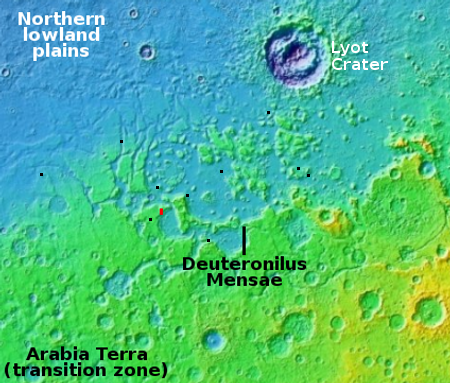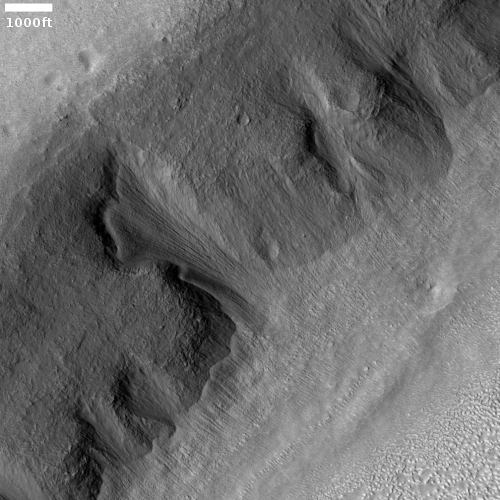Glacial falls on Mars
Cool image time! The photo to the right, cropped and reduced to post here, was taken on July 2, 2021 by the high resolution camera on Mars Reconnaissance Orbiter (MRO). It provides us just one more clear example of the many glaciers found in that 2,000-mile-long strip of chaos terrain at 30 to 47 degrees north latitude that runs between the northern lowland plains and the southern cratered highlands, a region I like to call Mars’ glacier country.
What makes this glacial feature interesting is that these ice-filled alcoves are south-facing, which in the northern hemisphere means they get the most sunlight. Yet, the ice here remains, well-protected by its layer of dust and debris. Think of the dirty ice slush that manages to survive the longest on city streets in the spring. The dirt acts as protection so that the ice takes more time to melt.
The overview map as always provides our context.

The small red rectangle marks the location of this image. The many black dots mark the locations of many of the cool images of other glacial features in Deuteronilus Mensae that I have featured previously. Do a search on Behind the Black for “Deuteronilus” and you will quickly find them.
Nor is this selection complete. Practically every photo taken by high resolution cameras in this region shows evidence of glacial features and erosion. This 2019 press release from Europe’s Mars Express orbiter adds further weight to these MRO images:
This landscape shows clear and widespread signs of significant, lasting erosion. As is common with fretted terrain, it contains a mix of cliffs, canyons, scarps, steep-sided and flat-topped mounds (mesa), furrows, fractured ridges and more, a selection of which can be seen dotted across the frame.
These features were created as flowing material dissected the area, cutting through the existing landscape and carving out a web of winding channels. In the case of Deuteronilus Mensae, flowing ice is the most likely culprit. Scientists believe that this terrain has experienced extensive past glacial activity across numerous martian epochs.
It is thought that glaciers slowly but surely ate away at the plains and plateaus that once covered this region, leaving only a scattering of steep, flat, isolated mounds of rock in their wake.
Smooth deposits cover the floor itself, some marked with flow patterns from material slowly moving downhill – a mix of ice and accumulated debris that came together to form and feed viscous, moving flows of mass somewhat akin to a landslide or mudflow here on Earth.
Studies of this region by NASA’s Mars Reconnaissance Orbiter [MRO] have shown that most of the features seen here do indeed contain high levels of water ice. Estimates place the ice content of some glacial features in the region at up to 90%. This suggests that, rather than hosting individual or occasional icy pockets and glaciers, Deuteronilus Mensae may actually represent the remnants of an old regional ice sheet. This ice sheet may once have covered the entire area, lying atop the plateaus and plains. As the martian climate changed this ice began to shift around and disappear, slowly revealing the rock beneath. [emphasi mine]
The highlighted sentence is the most important. The glaciers in Mars’ glacier country likely represent the edge of the vast ice sheets that appear to generally cover the lowland plains to the north.
On Christmas Eve 1968 three Americans became the first humans to visit another world. What they did to celebrate was unexpected and profound, and will be remembered throughout all human history. Genesis: the Story of Apollo 8, Robert Zimmerman's classic history of humanity's first journey to another world, tells that story, and it is now available as both an ebook and an audiobook, both with a foreword by Valerie Anders and a new introduction by Robert Zimmerman.
The print edition can be purchased at Amazon or from any other book seller. If you want an autographed copy the price is $60 for the hardback and $45 for the paperback, plus $8 shipping for each. Go here for purchasing details. The ebook is available everywhere for $5.99 (before discount) at amazon, or direct from my ebook publisher, ebookit. If you buy it from ebookit you don't support the big tech companies and the author gets a bigger cut much sooner.
The audiobook is also available at all these vendors, and is also free with a 30-day trial membership to Audible.
"Not simply about one mission, [Genesis] is also the history of America's quest for the moon... Zimmerman has done a masterful job of tying disparate events together into a solid account of one of America's greatest human triumphs."--San Antonio Express-News
Cool image time! The photo to the right, cropped and reduced to post here, was taken on July 2, 2021 by the high resolution camera on Mars Reconnaissance Orbiter (MRO). It provides us just one more clear example of the many glaciers found in that 2,000-mile-long strip of chaos terrain at 30 to 47 degrees north latitude that runs between the northern lowland plains and the southern cratered highlands, a region I like to call Mars’ glacier country.
What makes this glacial feature interesting is that these ice-filled alcoves are south-facing, which in the northern hemisphere means they get the most sunlight. Yet, the ice here remains, well-protected by its layer of dust and debris. Think of the dirty ice slush that manages to survive the longest on city streets in the spring. The dirt acts as protection so that the ice takes more time to melt.
The overview map as always provides our context.

The small red rectangle marks the location of this image. The many black dots mark the locations of many of the cool images of other glacial features in Deuteronilus Mensae that I have featured previously. Do a search on Behind the Black for “Deuteronilus” and you will quickly find them.
Nor is this selection complete. Practically every photo taken by high resolution cameras in this region shows evidence of glacial features and erosion. This 2019 press release from Europe’s Mars Express orbiter adds further weight to these MRO images:
This landscape shows clear and widespread signs of significant, lasting erosion. As is common with fretted terrain, it contains a mix of cliffs, canyons, scarps, steep-sided and flat-topped mounds (mesa), furrows, fractured ridges and more, a selection of which can be seen dotted across the frame.
These features were created as flowing material dissected the area, cutting through the existing landscape and carving out a web of winding channels. In the case of Deuteronilus Mensae, flowing ice is the most likely culprit. Scientists believe that this terrain has experienced extensive past glacial activity across numerous martian epochs.
It is thought that glaciers slowly but surely ate away at the plains and plateaus that once covered this region, leaving only a scattering of steep, flat, isolated mounds of rock in their wake.
Smooth deposits cover the floor itself, some marked with flow patterns from material slowly moving downhill – a mix of ice and accumulated debris that came together to form and feed viscous, moving flows of mass somewhat akin to a landslide or mudflow here on Earth.
Studies of this region by NASA’s Mars Reconnaissance Orbiter [MRO] have shown that most of the features seen here do indeed contain high levels of water ice. Estimates place the ice content of some glacial features in the region at up to 90%. This suggests that, rather than hosting individual or occasional icy pockets and glaciers, Deuteronilus Mensae may actually represent the remnants of an old regional ice sheet. This ice sheet may once have covered the entire area, lying atop the plateaus and plains. As the martian climate changed this ice began to shift around and disappear, slowly revealing the rock beneath. [emphasi mine]
The highlighted sentence is the most important. The glaciers in Mars’ glacier country likely represent the edge of the vast ice sheets that appear to generally cover the lowland plains to the north.
On Christmas Eve 1968 three Americans became the first humans to visit another world. What they did to celebrate was unexpected and profound, and will be remembered throughout all human history. Genesis: the Story of Apollo 8, Robert Zimmerman's classic history of humanity's first journey to another world, tells that story, and it is now available as both an ebook and an audiobook, both with a foreword by Valerie Anders and a new introduction by Robert Zimmerman.
The print edition can be purchased at Amazon or from any other book seller. If you want an autographed copy the price is $60 for the hardback and $45 for the paperback, plus $8 shipping for each. Go here for purchasing details. The ebook is available everywhere for $5.99 (before discount) at amazon, or direct from my ebook publisher, ebookit. If you buy it from ebookit you don't support the big tech companies and the author gets a bigger cut much sooner.
The audiobook is also available at all these vendors, and is also free with a 30-day trial membership to Audible.
"Not simply about one mission, [Genesis] is also the history of America's quest for the moon... Zimmerman has done a masterful job of tying disparate events together into a solid account of one of America's greatest human triumphs."--San Antonio Express-News


